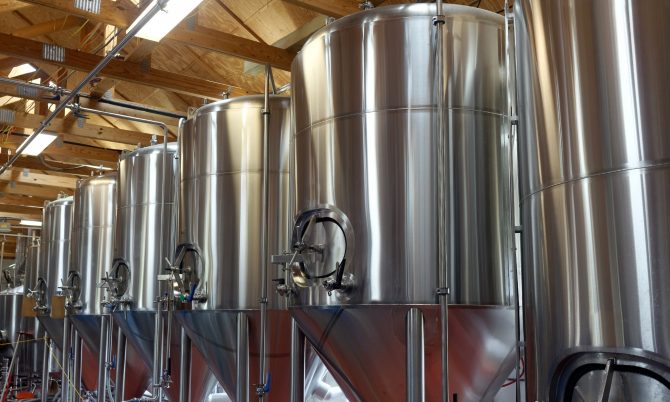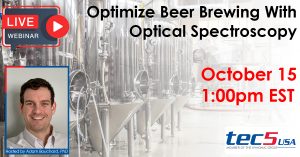Traditionally, the brewing process has been viewed as an artform, but with the overall beer market reaching $116.0 billion in 2019 and higher demands in quality and consistency in the craft brewing industry, scientific analysis is now a crucial element of the fermentation process.
The four ingredients used for beer production – water, malt, hops, and yeast – all play a vital role in the brewing process. The mashing of the malt and water activates alpha amylase and beta amylase in the malt, which break down long and short chain sugars, respectively. These sugars have different roles – the long chain sugars are responsible for the body and mouth feel of the product, while the short chain sugars are responsible for alcohol production. Hops are then added to this mixture to create the desired flavor and aroma before yeast converts the sugars into ethanol and carbon dioxide through fermentation.
Dry hopping is said to preserve hop oils and add more flavor and aroma, without extra bitterness. During Dry hopping, hops are added either at the beginning of fermentation or later, well into the fermentation process. Historically, any changes to the beer recipe would only be made once the Brew Master had tasted the finished product, and based on their verdict, the hops components would be adjusted. The alcohol content would then be calculated by comparing the original gravity (sugar content before fermentation) and the final gravity (sugar content after fermentation) to determine the alcohol by volume (ABV).
Near-Infrared spectroscopy (NIRS) offers an easy, effective, and cost-efficient solution to monitor critical parameters, such as hops components or alcohol concentration. Real-time, in-line monitoring enables enhanced control over the production process, and in turn, the quality and flavor of the final product.
Hops Components and Alcohol Content are Key Parameters
While current quality control still focuses on the key parameters of hops components and alcohol content, these assessments are now commonly made using high-performance liquid chromatography (HPLC), which provides highly accurate and precise data. However, this analysis requires timely sample preparation and is not always performed in-house, so it can take hours, even days to obtain results, which can lead to out-of-spec batches that require reprocessing, reducing efficiency. In addition, the technique requires a highly skilled operator and produce hazardous waste, adding more cost to the quality control process as these materials require special disposal.
NIRS offers many advantages over these existing methods; it is non-destructive, offers real-time analysis, requires little to no sample preparation, and does not generate waste products. NIRS is also a multivariate technique, providing information about several analytes in a single spectrum. This ability enables brewers to characterize all aspects of the hops components – alpha- and beta-acids, essential oils, hydrocarbons, and flavonoids – as well as the alcohol content with a single instrument.
tec5USA Inline Rapid Spectroscopy
Laboratory-based near-infrared (NIR) spectrometers are often bulky and provide comprehensive analysis for a wide range of compounds. While these features enable in-depth scientific research, they are not suited to incorporation into industrial manufacturing processes.
Compact near-infrared spectrometers (CNIRS) provided by tec5USA are compact, with a footprint roughly the size of a laptop, and can be incorporated into the brewing production line. Their micro-electromechanical system (MEMS) device allows the mechanical structures to be miniaturized and integrated with electrical circuitry. These instruments are also equipped with a Fabry-Perot interferometer enabling variable and tunable wavelength ranges between 1.10–2.50 μm and have a high signal-to-noise ratio (>10,000) to ensure accurate and precise data is recorded. In addition, they are built with rugged optics and electronics and have minimal moving parts, to ensure they are robust and able to withstand 24/7 operation.
By placing a CNIRS in the circulation loops or in the downstream piping after the dosing pumps, it can analyze the hops components and determine the ethanol content. The CNIRS, with tecSaaS embedded electronics, acts as a real-time sensor and remotely communicates to the production line software to adjust the machinery hardware as required. For example, real time monitoring of hops components, while recirculating the beer during fermentation, allows control systems to automate hops additions. Based on the concentration of the hops components, the system can trigger injections from the dosing pump until a desired set point is reached.
Automated Beer Fermentation with Product Consistency
This innovative, inline technology offers many advantages over the current methods; it offers non-destructive, real-time quality control, with no waste. Plus, its ability to automatedly monitor the fermentation steps enhances product consistency and presents cost savings due to the minimization of reprocessing, as well as on time, energy, and reagent costs of traditional laboratory measurements. Overall, these new advances in the beer fermentation process enable brewers to reliably deliver their characteristic flavor and aroma for us all to enjoy.
About tec5USA
tec5USA is the North American subsidiary of tec5 AG, who belong to the publicly traded company Nynomic AG, an international group and leading manufacturer of products for permanent, non-contact and non-destructive optical measurement technology.
Rather than waiting for time-consuming laboratory measurements, tec5USA’s instruments rapidly measure time-critical chemical and physical parameters to react immediately to deviations in the production line, permitting real-time process verification. This hence enables consistent quality, waste minimization and rework reduction, yield maximization, end-to-end supply chain optimization and pay per content. Industries tec5USA serves are semiconductor manufacturing equipment, thin film technology, chemistry, petrochemistry, environmental technology, the mining industry, biotechnology and pharma, food, feed and beverages as well as agriculture.
WEBINAR OCTOBER 15TH Optimizing Beer Brewing Through Spectroscopy
Summary: tec5USA is implementing near-infrared (NIR) spectroscopy in the end-to-end beer brewing process. Using chemometric models and real-time NIR detectors we quantify fermentable and non-fermentable sugars in the wort; IBU before pitching yeast and pre/post centrifuge; and carbohydrates, alcohol and diacetyl in the fermenter.
Agenda: What are the application targets in the brewing process? Why use tec5USA? How does NIR work, and how does it work for all these analytes? How does tec5USA equipment perform and how is it installed? What is the process for testing the equipment for my brewery with my recipes?
SIGN UP HERE





